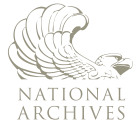
Back National Archives and Records Administration Afrikaans إدارة الأرشيف والوثائق الوطنية Arabic اداره المحفوظات و السجلات الوطنيه ARZ National Archives and Records Administration AST Milli Arxiv və Sənədlər İdarəsi (ABŞ) Azerbaijani Нацыянальнае кіраванне архіваў і дакументацыі (ЗША) Byelorussian National Archives and Records Administration Catalan National Archives and Records Administration Czech National Archives and Records Administration Danish National Archives and Records Administration German
| NARA | |
 Official seal | |
 National Archives logo, a stone eagle inspired by the architecture of the National Archives Building in Washington, D.C.[1] | |
| Agency overview | |
|---|---|
| Formed | June 19, 1934 (Independent Agency April 1, 1985)[2] |
| Preceding agency |
|
| Type | Independent |
| Jurisdiction | U.S. Federal Government |
| Headquarters | National Archives Building 700 Pennsylvania Avenue NW, Washington, D.C., U.S. 38°53′33.6″N 77°01′22.6″W / 38.892667°N 77.022944°W |
| Motto | Littera scripta manet (Latin for "the written word endures")[3] |
| Employees | 2,848 (FY 2021)[4] |
| Annual budget | $397 million (FY 2021)[4] |
| Agency executives |
|
| Child agency | |
| Website | www |
The National Archives and Records Administration (NARA) is an independent agency of the United States government within the executive branch,[5] charged with the preservation and documentation of government and historical records. It is also tasked with increasing public access to those documents that make up the National Archives.[6] NARA is officially responsible for maintaining and publishing the legally authentic and authoritative copies of acts of Congress, presidential directives, and federal regulations. NARA also transmits votes of the Electoral College to Congress.[7] It also examines Electoral College and constitutional amendment ratification documents for prima facie legal sufficiency and an authenticating signature.[8]
The National Archives, and its publicly exhibited Charters of Freedom, which include the original United States Declaration of Independence, United States Constitution, United States Bill of Rights, Emancipation Proclamation (starting in 2026),[9] and many other historical documents, is headquartered in the National Archives Building in Washington, D.C.
- ^ "Celebrate July 4 with New Logo and 1st Ever Parade Float!". National Archives and Records Administration. June 30, 2010.
- ^ "Archival Milestones". National Archives and Records Administration. Retrieved March 31, 2011.
- ^ Timothy Walch. "Guardians of Heritage: Introduction" (PDF). NARA.
- ^ a b Cite error: The named reference
Fiscal Year 2022 Budget Requestwas invoked but never defined (see the help page). - ^ Stephanie (April 18, 2013). "What's the difference between the National Archives and the Library of Congress?". Education Updates. Retrieved August 12, 2022.
- ^ Mengel, David (May 2007). "Access to United States Government Records at the U.S. National Archives and Records Administration" (PDF). Society of American Archivists. Archived from the original (PDF) on July 13, 2010. Retrieved April 29, 2019.
- ^ "Elections and the Electoral College". National Archives. March 15, 2017. Retrieved April 22, 2019.
- ^ "The Constitutional Amendment Process". Archives.gov. National Archives and Records Administration. Retrieved July 27, 2014.
- ^ More • •, Maggie (June 20, 2024). "Emancipation Proclamation to go on permanent display at National Archives in 2026". NBC4 Washington. Retrieved September 22, 2024.